FIFA announced the stadiums of Confederations Cup 2013, which should be a reherseal for the FIFA World Cup.
The Confederations Cup takes place one year before the Cup, and is disputed by eight countries: the host country, the champion of the previous World Cup (Spain), and each of the winner of the six Continental Cups.

Ideally, all the twelve stadia should be ready for the Confederations Cup; by staging an actual match, the stadium would be tested as to its infrastructure (pitch, seats, illumination) and its functionality (ways of access, tickets control, parking area, etc).
However, six of the twelve stadiums are already excluded from the Confederations Cup.
Four stadiums are confirmed: the National Stadium, in Brasilia (will host the opening match, and only that one); Maracana, in Rio de Janeiro (will host the final match); Mineirao, in Belo Horizonte; and Castelao, in Fortaleza.
FIFA will visit two other stadiums before the end of this year to confirm whether or not they will be ready for the Confederations: Arena Pernambuco, in Recife, and Fonte Nova, in Salvador.
Recife and Salvador are running to get their stadiums ready; the Confederations Cup will see some great matches (maybe Brazil x Spain or Brazil x England – or whichever other country wins the Eurocup), and will draw the attention of the World.
Hosting the Confederations Cup will bring exposure, free marketing and a lot of business for the host cities.
The Confederations Cup takes place one year before the Cup, and is disputed by eight countries: the host country, the champion of the previous World Cup (Spain), and each of the winner of the six Continental Cups.

Ideally, all the twelve stadia should be ready for the Confederations Cup; by staging an actual match, the stadium would be tested as to its infrastructure (pitch, seats, illumination) and its functionality (ways of access, tickets control, parking area, etc).
However, six of the twelve stadiums are already excluded from the Confederations Cup.
Four stadiums are confirmed: the National Stadium, in Brasilia (will host the opening match, and only that one); Maracana, in Rio de Janeiro (will host the final match); Mineirao, in Belo Horizonte; and Castelao, in Fortaleza.
FIFA will visit two other stadiums before the end of this year to confirm whether or not they will be ready for the Confederations: Arena Pernambuco, in Recife, and Fonte Nova, in Salvador.
Recife and Salvador are running to get their stadiums ready; the Confederations Cup will see some great matches (maybe Brazil x Spain or Brazil x England – or whichever other country wins the Eurocup), and will draw the attention of the World.
Hosting the Confederations Cup will bring exposure, free marketing and a lot of business for the host cities.
Stadiums of World Cup Brazil 2014
March 4, 2012The post below bring information about each of the twelve stadiums which will stage matches of the World Cup Brazil 2014.
Each post brings or will bring:
- Name, capacity and location of the stadium
- Official name, and origins of name
- the designer and the constructor of the stadium
- photos and images of the stadium, including: artistic images of the project, photos of the old stadium, photos of the new stadium being built
- when available, photos of the stadiums during the Cup, as well as the teams which will be performing there.
The Stadiums and respective locations are:
Each post brings or will bring:
- Name, capacity and location of the stadium
- Official name, and origins of name
- the designer and the constructor of the stadium
- photos and images of the stadium, including: artistic images of the project, photos of the old stadium, photos of the new stadium being built
- when available, photos of the stadiums during the Cup, as well as the teams which will be performing there.
The Stadiums and respective locations are:
- Maracana, in Rio de Janeiro
- Arena Itaquera, in Sao Paulo
- Fonte Nova, in Salvador
- Arena Amazonia, in Manaus
- Arena Pantanal, in Cuiaba
- Arena da Baixada, in Curitiba
- Mineirao, in Belo Horizonte
- Arena Pernambuco, in Recife
- Arena das Dunas, in Natal
- Castelao, in Fortaleza
- Beira-Rio, in Porto Alegre
- National Stadium Mane Garrincha, in Brasilia
Maracana, Rio de Janeiro
March 1, 2012
City: Rio de Janeiro, capital of the State of Rio de Janeiro.
Capacity: 76,000 attendants.
Maracana will continue to be the undisputed biggest stadium in Brazil. Three stadiums claim to be the second biggest: Castelao, Mineirao and Morumbi, all with capacity around 67,000 attendants.
If Maracana reaches full capacity during the Cup, it will be just fraction of the official record, of nearly 200,000 people, set on the finalmatch of the World Cup 1950 (source).
Official name: Estádio Jornalista Mário Filho.
Origins of name: Mario Filho was a journalist, who used his newspapers to start a campaign for the construction of the stadium in the neighborhood of Maracana.
Maracana is a word of indigenous origin, which refers to certain species of macaw; a river was named after the birds, a district of Rio was named after the river, and the stadium was named after the district.
Design and architecture: the Public Works Department of Rio, Fernandes Arquitetos Associados and Schlaich Bergermann und Partner (this one worked also in Curitiba).
Constructors: Andrade Gutierrez (also working in Manaus and Brasilia), Odebrecht (also working in Sao Paulo and Recife) and Delta.
Estimated cost: costs are mounting quickly: R$ 500 million (December 2009), R$ 720 million (June 2010), R$ 1 billion (May 2011).
Rio has a historic of corruption to build public stadiums. When Rio organized the Pan American Games of 2007, the initial estimated budget was around US$ 200 million, and the actual cost ended up being ten times that amount. The cost Maracana stadium alone was nearly US$ 200 million, money which should suffice to prepare the venue for the Olympic Games of 2016.
Matches and teams: Maracana will stage seven matches of the World Cup, including the final match; only Brasilia will stage as many matches (the smaller cities, such as Natal and Cuiaba, will stage only four matches).
The Brazilian team will play in Maracana only if it manages to reach the final match.
It’s likely that several national teams stay in Rio de Janeiro, even if not playing here; Rio has many training venues, and an excellent hotel infrastructure, which could be used by the teams – and being the most beautiful Brazilian city, will certainly please the fans who follow the teams.
Schedule of matches:
June 15th (Sunday):
June 18th (Wednesday):
June 22nd (Sunday):
June 25th (Wednesday):
June 28th (Sunday): Round of 16:
July 4th (Friday): Quarter Final:
July 13th (Sunday): Final match:
Map of Maracana stadium:
More photos and images of Maracana:

The old (2009) Maracana.
Notice the large train station in the background, which the Government will push as the main access to the matches; Maracana is in a busy neighbourhood, and traffic is a problem.
In front, one sees Maracanazinho (arena for indoor sports) and Parque Aquatico Julio Delamare; there were attempts to remove both of them to make more room for the expansion of Maracana, but the idea didn’t prevail.

Above: August 2010, tractors start working in Maracana.

Above: December 2011 (source).

Above: February 2012 (source: Government of Rio).
More information:
» World Cup in Rio.
Arena Corinthians Itaquera – Sao Paulo
March 1, 2012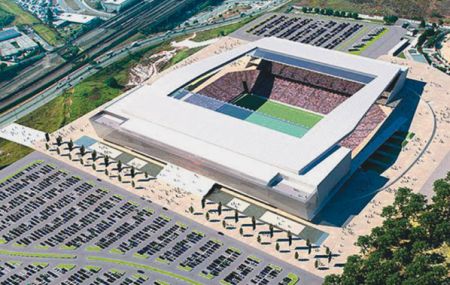
City: Sao Paulo, capital of the State of Sao Paulo.
Capacity: 48,000 attendants.
This stadium was chosen as stage of the opening match of the World Cup; FIFA required a minimum capacity of 65,000 attendants. The owner of the stadium, Corinthians, will install removable structures to increase capacity during the World Cup.
Owner of stadium: Corinthians.
This is one of the three privately owned stadiums of the World Cup 2014; the other two are Beira-Rio in Porto Alegre and Arena da Baixada in Curitiba.
Corinthians is the most popular club in Sao Paulo, as measured by number of fans, and the second one in Brazil.
For decades, Corinthians had been planning to build an stadium up to its popularity; today, the club owns a small stadium called Parque Sao Jorge, which lacks the structure to stage important matches (i.e., any match where Corinthians is playing).
Controversies:
In the 1980s, the Government had granted the use of a large piece of land in Itaquera (a poor district in the suburbs of the city), provided that Corinthians built an stadium right then. Since then, Corinthians had been trying to raise funds to build the stadium, but always failed.
The first option of stadium to host matches of the Cup in Sao Paulo was Morumbi, which belongs to Sao Paulo FC. Sao Paulo FC, however, didn’t agree to make the investments demanded by FIFA.
The then President of Corinthians, Andre Sanchez, is a very close friend of the President of the World Cup Local Committee, Ricardo Teixeira.
By threatening to exclude Sao Paulo of the Cup, FIFA and Teixeira convinced the Federal Government to accept Itaquerao as the venue, and to help Corinthians get the funds necessary to do the works.
So: FIFA still maintains Sao Paulo as a host (exclude Sao Paulo from the World Cup Brazil would be like exclusing Moscow from the World Cup Russia), Corinthians will build an stadium with cheap (or free) money; and Ricardo Teixeira keeps his friend happy.
The problems: the Federal Government will provide funds to a private party to build a private stadium; the new stadium will be in the distant suburb of Sao Paulo, lacking much infrastructure; it is uncertain whether or not the stadium will be ready for the World Cup.
Official name: not defined yet.
Both Arena Itaquera and Itaquerao (the Bit Itaquera) have been used.
Corinthians already confirmed that selling the naming rights of the stadium will be an important source of revenue; no contract was signed yet.
Design: Coutinho Diegues Cordeiro Arquitetos.
Constructor: Odebrecht (also worked in Recife).
Estimated cost: R$ 900 million.
As Itaquerao is a private enterprise, Corinthians is not obliged to conduct public biddings, nor to disclose actual costs; also, the team has freedom (within limits imposed by FIFA) to change the design or the engineering of the stadium.
Matches and teams: Sao Paulo will host six matches of the World Cup Brazil 2014.
Sao Paulo managed to bring the opening match of the Cup to Itaquerao – the event, which will happen on June 12th 2014, should set new records of world audience, hence drawing lots of attention to the city.
Sao Paulo, however, will host less matches than Rio de Janeiro (which was expected, as Rio will host the final match) and also to Brasilia (which will host seven matches, including the dispute for third place).
Schedule of matches:
June 12th (Thursday): Brazil x
June 19th (Thursday):
June 23rd (Monday):
June 26th (Thursday):
July 1st (Tuesday): Round of 16
July 9th (Wednesday): Semi-final
Map of Itaquerao:
Photos and Images of Itaquerao.

Above: the stadium will be linked to the station Corinthians Itaquera of the Sao Paulo metro.

Above: the machines didn’t start working until May 2011 (photo: Sao Paulo Government).
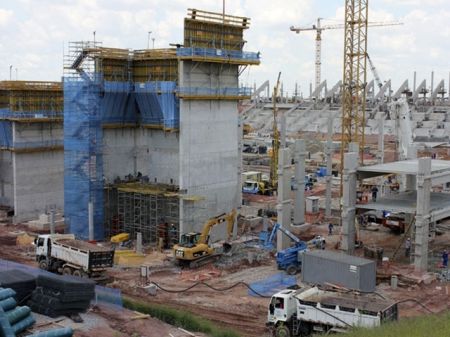
Above: February 2012; according to the Brazilian Government, workers are doing three shifts (24 hours a day).
More Information:
» World Cup in Sao Paulo.
Fonte Nova, Salvador
March 1, 2012
City: Salvador, capital of the State of Bahia.
Capacity: 55,000 attendants.
Salvador has two teams, Bahia and Vitoria, with two of the most passionate fans in Brazil; in matches between these two teams, or between one of them and other major Brazilian team, the attendance reaches full capacity.
Official name: Estádio Otávio Mangabeira.
Origin of name: Otávio Mangabeira was the Governor of Bahia when the stadium was inaugurated, in 1951.
Fonte Nova means “new fountain” in Portuguese; the stadium is situated near Itororó Dam (see photo above), where there used to be water fountains for public use.
Design: Setepla and Schulitz+Partner.
Constructors: Odebrecht (worked also in Recife) and OAS (worked also in Natal).
Estimated cost: R$ 785 million.
Matches and Teams: Salvador will host six matches of the World Cup 2014.
The Brazilian team may play here, but that’s unlikely (the team should finish second in the first stage).
Salvador and Bahia have probably the largest infrastructure of resorts in Brazil (accommodation with large space for training and leisure), and certainly several national teams will stay here during the Cup.
Dates of matches:
June 13th (Friday):
June 16th (Monday):
June 20th (Friday):
June 25th (Wednesday):
July 1st (Tuesday):
July 5th (Saturday):
If the works in the stadium progress as expected, Salvador will be also a host of the Confederations Cup 2013.
Map of Fonte Nova, Salvador:
Images and photos of Fonte Nova:

Above: Implosion of the old Fonte Nova, in August 2010. The stadium was already condemned since november 2007, when part of the structure collapsed during a match, killing seven people. Costs to rebuild the old stadium were high, and results doubtful. When FIFA announced Salvador as one host city, the decision was made to implode the old stadium and rebuild from scratch.

Above: Fonte Nova in February 2012 (photo: Odebrecht).
More information:
» World Cup in Salvador.
Arena Amazonia, Manaus
February 29, 2012
City: Manaus, capital of the State of Amazonas.
Capacity: 44,000 attendants.
Manaus has no tradition at all in football; the local teams can’t attract more than a few thousand attendants per match; the stadium is certain to be under used after the World Cup is finished.
Official name: Estádio Vivaldo Lima.
Origins of name: Vivaldo Palva Lima was a doctor and politician (Senator).
Unlike several Brazilian stadiums which were named after the Governor who built them (like Castelao, Mineirao, Machadao, Verdao and others), the Vivaldao was named after a policitian who was already dead when the stadium was inaugurated.
Vivaldo Lima had relevant participation in the social, cultural, philanthropic and sports scene of Manaus; to mention only his sports merits, he was President of two important clubs in Manaus, Nacional and Fast.
During the World Cup, Brazil will try to push the name Arena Amazonia; the Amazon is the largest rain forest in the World, with potential to attract tourists from all over the World.
The main reason to choose Manaus as a host city was to give it an opportunity to gain world exposure during the World Cup.
Design: GMP (also worked in the Mineirao project).
Constructor: Andrade Gutierrez (also worked in the National Stadium of Brasilia).
Estimated cost: R$ 533 million.
Matches and teams: Manaus will host only four matches of the World Cup Brazil.
Dates of matches:
June 14th (Saturday):
June 18th (Wednesday):
June 22nd (Sunday):
June 25th (Wednesday):
Map of Arena Amazonas:
More photos and images:

Above: project of the new Arena Amazonia, with the city of Manaus and the river Amazonas in the background.

Photo above: photo of the old Vivaldao, from aproximately the same point of view as the previous image.
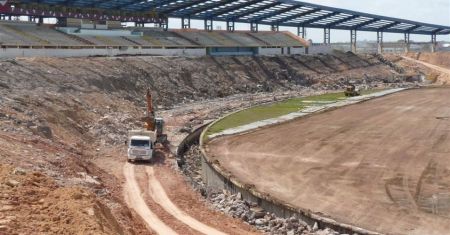
Above: August 2010, the demolition of Vivaldao was nearly finished.

Above: Arena Amazonia, January 2012.
More information:
» World Cup in Manaus.
Arena Pantanal, Cuiaba
February 29, 2012
City: Cuiaba, capital of the State of Mato Grosso.
Capacity: 43,600 attendants.
Official name: Estádio José Fragelli.
Origin of name: Jose Fragelli was Governor of Mato Grosso from 1970 to 1974; the stadium started building during his term in office.
The stadium is more commonly referred to as Verdao (the Big Green), due to the fact that both inside and outside of the stadium, the predominant color is green (see photo further below).
The Government of Mato Grosso will use the World Cup try to push the new name, Arena Pantanal. Pantanal is one of the largest and richest biomes in Brazil (it beats the Amazon in variety of fauna), with potentials to attract eco-tourists from all over the World; actually, the main reason to elect Cuiaba as a host city was to bring marketing exposure to the Pantanal.
Design: GCP.
Constructors: Mendes Junior and Santa Barbara.
Estimated cost: R$ 600 million.
Teams and matches: Cuiaba will be one of the four host cities which will host only four matches of the World Cup 2014 (the other ones are Manaus, Curitiba and Natal); these are considered the least relevant host cities.
Cuiaba is, along with Manaus, the most isolated of the World Cup cities, and one of the smallest in size; even though Cuiaba should become a success with eco-tourists, it is unlikely that the National Teams would prefer to have the city as a base.
Dates of matches:
June 13th (Friday):
June 17th (Tuesday):
June 21st (Saturday):
June 24th (Tuesday):
Map of the Arena Pantanal Stadium:
More images and photos of Arena Pantanal:
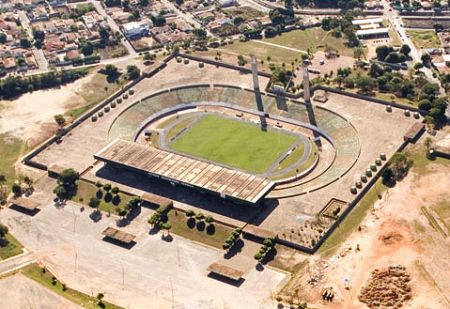
Photo above: the old Verdao (the Big Green); notice the predominance of Green all around the stadium.
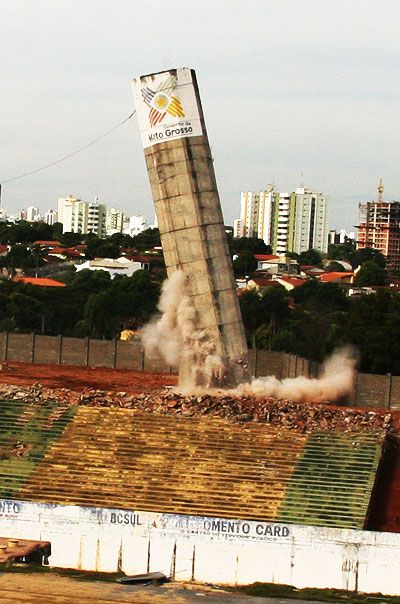
Above: in May 2010, with the implosion of the second tower, the entire stadium is already down.

The new Pantanal aims to be the most eco-friendly stadium in Brazil; the project shows a preoccupation with an optimum use of space.

Above: December 2011.
More information:
» World Cup in Cuiaba (see also information in Portuguese).
Arena da Baixada, Curitiba
February 29, 2012
City: Curitiba, capital of the State of Parana.
Capacity: 42,000 attendants.
Official name: Estádio Joaquim Américo Guimarães.
Origin of name: Joaquim Americo Guimaraes was the founder of Internacional Football Club, which later would become today’s Clube Atletico Paranaense, owner of the stadium.
The stadium is much more commonly referred to as Arena da Baixada. “Baixada”, in Portuguese, means “the low areas”; when Joaquim Guimaraes first thought of building a stadium, back in 1912, he purchased an area in the then distant, lower, wet suburbs of Curitiba, called “Baixadao da Agua Verde”; today, Agua Verde (which means Green Water), where the stadium is located, is one of the noblest areas of Curitiba.
Owner of Stadium: Clube Atletico Paranaense (Brazilian champion of 2001, several times champion of the State).
Arena da Baixada is one of the two privately owned stadiums of the World Cup 2014; the other one is Beira-Rio, in Porto Alegre.
Thanks to professional management, Arena da Baixada is considered one of the most modern stadiums in Brazil (it was the first to offer free wi-fi, and one of the few with a central surveillance system).
On the other hand, because the stadium is less subject to political exposition, there are fewer information (such as cost of investments, photos, etc) about the progress of the works; Atletico is spending their own money, so they have less obligation to provide information to the public.
Design and architecture: Carlos Arcos and many others.
Constructors: CYD, Schlaich Bergermann und Partner and others.
Estimated cost: R$ 180 million.
This is the lowest budget of all venues of the World Cup 2014, and again it has to do with the fact that the stadium is privately owned.
Atletico must think on the return of investments (for example, to take loans, to hire contractors, etc); there once was a possibility that, for being so cautious with investments, Arena da Baixada would be discarded from the Cup.
Most of the original stadium (which had undergone complete renovation about ten years ago) was preserved, and just an expansion is planned; today’s capacity is 25,000, which should jump to about 42,000.
Atletico had for a few years a naming rights contract with Kyocera; the contract should be renovated in 2008 (when Brazil had already been announced as the host of the World Cup 2014), but Atletico was so sure that Arena would be a stage of matches that it decided not to renovate it.
Matches and teams: Curitiba will host only four matches of the World Cup, all in the first stage.
It is certain that Brazil will not play in Curitiba.
Possible candidates: Curitiba has a cold climate in June, which could attract countries looking to escape the hot weather, such as Sweden or Norway. Besides, the State of Parana has communities of immigrants from Japan, Italy and Poland, whose teams could feel a bit more at home in Curitiba.
Dates of matches:
June 16th (Monday):
June 20th (Friday):
June 23rd (Monday):
June 26th (Thursday):
Map of Arena da Baixada, Curitiba:
More photos and images:
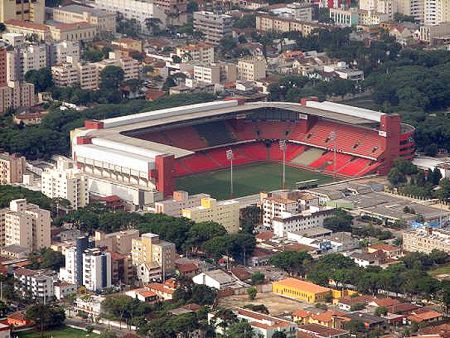
Photo above: the Arena in 2008; even with the missing parts, the stadium was fully working.
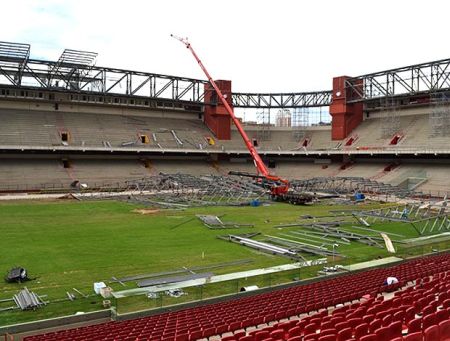
Photo above: February 2012.
More information:
» World Cup in Curitiba.
» Brazil World Cup.
Mineirao, Belo Horizonte
February 28, 2012
City: Belo Horizonte, capital city of the State of Minas Gerais.
Capacity: 67,000 attendants.
According to wikipedia, Mineirao is today the second largest stadium in Brazil (the largest one being Maracana). Morumbi used to be the undisputed second biggest, but after successive renovations (which increase comfort and reduce seat space), the number will fall under the current 68,000 (anyway, Morumbi will not host the Cup).
However, after the Cup, Castelao Stadium, in the northeastern city of Fortaleza, can become the second largest stadium in Brazil; official informed capacity was 67,037, but the figures (neither Mineirao’s nor Castelao’s) don’t make a clear distinction between actual attendance seatings, media seatings, VIP seatings, etc.
Official name: Estádio Governador Magalhaes Pinto.
Origin of name: Jose de Magalhaes Pinto was Governor of the State of Minas Gerais between 1961 and 1966; the stadium was built during his term in office.
The stadium is much more commonly referred to as Mineirao, which means “the big Mineiro” (Mineiro is someone who’s born in the State of Minas Gerais).
Design: Gustavo Penna e Associados and GMP.
Constructors: Construcap, Egesa and Hap.
Estimated cost: R$ 667 million.
Matches and teams: Belo Horizonte will host six matches of the World Cup, including one of the semi-finals.
In the likely event of the Brazilian team finishing first placed in the groups stage, then it will play a match in Belo Horizonte.
Dates of matches:
June 14th (Saturday):
June 17th (Tuesday):
June 21st (Saturday):
June 24th (Tuesday):
June 28th (Saturday): Round of 16
July 8th (Tuesday): semi-final
Belo Horizonte is confirmed as one of the host cities of the Confederations Cup, in 2013.
It is worth noticing that Minas Gerais was a host of the World Cup 1950, but matches were in the Estadio Independencia, and not in Mineirao (which didn’t exist).
Map of Mineirao stadium, Belo Horizonte:
More images and photos of Mineirao:

Above: artistic image of the complex Mineirao (football arena) and Mineirinho (indoor sports arena).

Photo above: October 2011.

Above: February 2012.
More information:
» World Cup Belo Horizonte (see also information in Portuguese).
» Brazil 2014
Arena Pernambuco – Recife
February 28, 2012
City: Recife, capital of the State of Pernambuco.
Actually, the stadium is located in the city of Sao Lourenco da Mata, in the metropolitan area of Recife; Sao Lourenco has no airport and poor travel infrastructure, hence the attendants of the Cup should stay in Recife.
Pernambuco is one of the most traditional States of the Brazilian football championships, so it was clear from the beginning that a host city should be here. However, two cities claimed the post: Recife (where free terrains are few and expensive) and Olinda (where there is plently of free land – but the pride of Recife would not accept as location of the new stadium).
An area in the border of the cities was the first attempted location – but the cost of buying the land proved to be prohibitive.
Sao Lourenco was then chosen as a compromise solution; the arena will be built in public lands.
Capacity: 46,000 attendants.
Official Name: Arena Pernambuco.
Origin of name: named after the State, Pernambuco.
The first name was Arena Capibaribe, after the big river which cuts the region.
Design: Fernandes Arquitetos Associados.
Constructor: Odebrecht.
The Government of Pernambuco signed a PPP contract with Odebrecht to build not only the Arena, but a whole complex called City of the Cup, which will include residential and business towers, hotel, shopping center, etc.(no other host city will have anything comparable).
American entertainment group AEG will operate the Arena.
Because there will be private investments and professional management, it is unlikely that Arena Pernambuco would become an underused white elephant after the Cup; one of the major clubs in Recife, Nautico, already signed a contract to stage matches in the Arena; besides, Recife is one of the fastest growing regions in Brazil (much thanks to the industrial complex of Suape), and is attracting more and more (and bigger) events.
Estimated cost: R$ 495 million.
Matches and teams: Recife will host five matches of the World Cup.
The teams are not defined yet, but it is known that the Brazilian team will not play in Recife.
The Dutch (who occupied Recife for 27 years) and the British (who had many business in the city in the beginning of the 20th century – so much that a British cemitery was created) have strong connections with Recife.
Dates of matches:
June 14th (Saturday):
June 20th (Friday):
June 23rd (Monday):
June 26th (Thursday):
June 29th (Sunday):
Recife can still be one of the hosts of the Confederations Cup, in 2013, provided that the works be finished before December 2012.
More images and photos of Arena Pernambuco:

Above: Cidade da Copa project; by 2014, only the Arena and a few buildings should be ready; the full project will extend for many years.

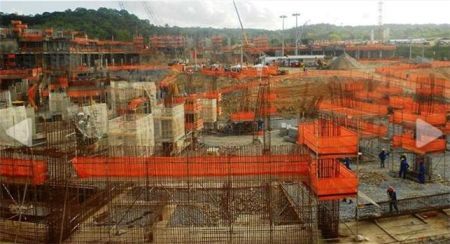
Two photos above: circa January 2012. Notice that not only a stadium, but an entire city is being built; the Government and FIFA claim that the stadium will be ready by January 2012. Notice also the city of Recife, far in the background.

Image above: in February 2012, Odebrecht informed that the works were 30% done and released new images of the stadium; the holes in the structure will allow light to shine from inside out.
More information:
» World Cup in Recife (read also information in Portuguese).
» World Cup 2014 Brazil.
You have read this article with the title October 2012. You can bookmark this page URL http://gaytunisia-to-da-ri.blogspot.com/2012/10/confederation-cup-2013-rehearsal-for.html. Thanks!















